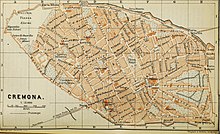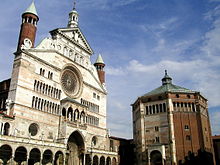Cremona
| Cremona | ||
|---|---|---|

|
|
|
| Country | Italy | |
| region | Lombardy | |
| province | Cremona (CR) | |
| Local name | Cremùna | |
| Coordinates | 45 ° 8 ′ N , 10 ° 2 ′ E | |
| height | 50 m slm | |
| surface | 70 km² | |
| Residents | 72,672 (Dec. 31, 2019) | |
| Population density | 1,038 inhabitants / km² | |
| Post Code | 26100 | |
| prefix | 0372 | |
| ISTAT number | 019036 | |
| Popular name | Cremonesi | |
| Patron saint | Sant'Omobono (November 13th) | |
| Website | www.comune.cremona.it | |
Cremona [ kreˈmoːna ] ( dt. obsolete: Kremun ) is a city in Lombardy , Italy , on the left bank of the Po river in the middle of the Po plain (Italian: Pianura padana ) with 72,672 inhabitants (as of December 31, 2019). At the same time, Cremona is the administrative seat of the province of the same name .
The city became particularly famous for the violin-making families Amati , Bergonzi , Guarneri and Stradivari . The traditional art of violin making in Cremona was declared an intangible cultural heritage by UNESCO in 2012.
history
Cremona was founded in 218 BC. BC, i.e. in the same year as Placentia ( Piacenza ), founded by the Romans as an outpost against the Gallic tribes. It was 190 BC. BC strengthened with 6000 new settlers and soon became one of the most prosperous cities in northern Italy. The city probably got in 90 BC The rights of a municipality .
After the second Battle of Bedriacum in 69, Cremona was captured and destroyed by the troops of the future emperor Vespasian , leaving only the temple of Mefitis . Vespasian ordered immediate rebuilding, but the city never regained its old prosperity. It was destroyed again by the Longobards under Agilulf in 605, rebuilt in 615 and ruled by Longobard dukes.
In the 9th century, the bishops of Cremona appear to have gained considerable secular power. The commune of Cremona is mentioned for the first time in a document from 1098 , with which the town received a territory called Isola Fulcheria from the Margravine Mathilde of Tuscien as a fief. It had to defend the new possessions in several wars against the neighboring municipalities. In the war of the Lombard League against Friedrich Barbarossa , Cremona finally joined the League after it had been involved in the destruction of Crema in 1160 and Milan in 1162, but did not take part in the Battle of Legnano .
In the clashes between the Guelphs and Ghibellines , Cremona, traditionally loyal to the emperor, sided with the Ghibellines and inflicted a decisive defeat on Parma in 1250. The most beautiful buildings in Cremona date from this period. After 1266, in connection with the final fall of the Hohenstaufen dynasty, the Guelphs came to power in Cremona. The city rebelled against King Henry VII in 1311 , but eventually surrendered; Numerous rights were withdrawn from the city by order of Heinrich, and the city fortifications were torn down. Eventually Cremona was taken over by Galeazzo I. Visconti in 1322 .
In 1406 it fell to Cabrino Fondulo, who with great celebrations Emperor Sigismund and Pope John XXIII. received the latter on his way to the Council of Constance . He handed the city over to Filippo Maria Visconti in 1419 . In 1499 it was occupied by the Venetians , but in 1512 it fell to Massimiliano Sforza . After Sforza's death, France conquered the area. In 1518 it could be recaptured by imperial troops. In 1535 it came together with the rest of Lombardy to the Habsburgs (from 1544 to the Spanish line ).
The surprise attack on the French garrison on February 2, 1702 ( Battle of Cremona ) by Eugene of Savoy is one of the notable events of the War of the Spanish Succession : Irish mercenaries of the imperial troops who entered the city through the house of a priest were after a fierce battle again driven by Irish mercenaries in French service ( Régiment de Dillon under Major Daniel O'Mahoney) from the city, but were able to capture the French commander Marshal Villeroi . In 1707 the city was captured by Austrian troops.
Cremona flourished again under the Austrian Habsburgs in the 18th century. In the Italian Republic founded by Napoleon in 1797, it was the capital of a department. Together with the rest of Lombardy, Cremona came back to Austria in 1814 and became part of the Habsburg kingdom of Lombardy-Veneto .
After the defeat in the Sardinian War , Austria had to cede the area to France, which it exchanged with the Kingdom of Sardinia-Piedmont for Nice and Savoy in 1860 . In 1861 Cremona became part of the newly established Kingdom of Italy .
After the Second World War , the American military administration set up a DP camp in Cremona in 1945 for Jewish displaced persons (DP), most of whom had fled from Austria to northern Italy. The camp, which was administered by UNRRA , housed up to 1200 DPs who were transferred to southern Italy in 1947.
economy
Agriculture and the food industry based on it, as well as mechanical engineering, are important. An oil refinery company Tamoil was closed of 2010. The construction of string instruments has a long tradition in Cremona, which is still maintained.
traffic
Cremona has a connection to the A 21 (Turin – Brescia). In addition, the city is well connected to the neighboring towns in the Po Valley via a number of state and provincial roads. The Cremona Station is a railway junction , converge at the six railway lines. The city on the Po River also has an inland port . The Cremona-Migliaro airfield is used for general aviation .
Attractions
- The Museo del Violino, a museum with precious exhibits from the Cremonese violin making dynasties .
- The cathedral in Cremona , with a height of 110 m, is a symbol of the city.
- Cremona train station
climate
|
Average monthly temperatures and rainfall for Cremona
Source: ENEA: Archivio Climatico DBT
|
|||||||||||||||||||||||||||||||||||||||||||||||||||||||||||||||||||||||||||||||||||||||||||||||||||||||||||||||||||||||||||||||||||||||||||||||||||||||||||||||||||||
Town twinning
-
 Alaquàs , Spain
Alaquàs , Spain -
 Krasnoyarsk , Russia
Krasnoyarsk , Russia -
 Füssen , Germany (since 2018)
Füssen , Germany (since 2018)
Personalities
sons and daughters of the town
- Publius Quinctilius Varus (47/46 BC – 9 AD), Roman general
- Gerhard von Cremona, (approx. 1114–1187) scholar, translator of Arabic works
- Danesio dei Maineri (* first mentioned around 1430, 1452 in Cremona; † July 1482 in Roccabianca ), military and artillery engineer, active in the reinforcement of Montebello Castle in Bellinzona
- Vitale Albera (1799 – around 1850), doctor of law, revolutionary, refugee in Geneva , Giuseppe Mazzini's supporter
- Amati , family, five violin makers in four generations
- Lucia Anguissola (* between 1537 and 1542; † before 1566), painter
- Sofonisba Anguissola (1531 / 1532–1625), Renaissance painter
- Antonio Maria Viani (around 1555/1560 - 1629), painter and architect
- Lazzaro Caraffino (around 1590 - 1665), Bishop of Como
- Lazzaro Caraffino (1626–1665), bishop
- Antonio Beltrami (1724–1784), Baroque and Neoclassical painter
- Eugenio Beltrami (1835-1900), mathematician
- Giovanni Beltrami (1777-1854), glyptist
- Cesare Beltrami (* 1942), two-time Olympic participant
- Antonio Campi (1523–1587), painter
- Bernardino Campi (1522–1591), painter
- Galeazzo Campi (1477–1536), late Renaissance painter
- Giulio Campi (1500–1572), painter
- Vincenzo Campi (1530/1535 or 1536–1591), painter, architect, engraver, draftsman and cosmographer
- Pierre-Francisque Caroubel (1556–1611), early Baroque French violinist and composer
- Marta Cavalli (* 1998), cyclist
- Chiara Ferragni (* 1987), entrepreneur, blogger, influencer and model
- Fabio Galli (* 1969), beach volleyball player
- Guarnerius del Gesu (1698–1744), violin maker
- Aristide Guarneri (* 1938), football player
- Giuseppe Giovanni Guarneri (1666–1739), violin maker
- Mina (* 1940), pop and jazz singer
- Danilo Montaldi (1929–1975), writer, sociologist and politician
- Claudio Monteverdi (1567–1643), composer at the turn of the Renaissance to the Baroque
- Giulio Cesare Monteverdi (1573–1630 / 31), composer and brother of Claudio Monteverdi
- Valentina Rodini (* 1995), rower
- Francesco Sfondrati (1493–1550), cardinal
- Lorenzo Storioni (1744–1816), master violin maker
- Antonio Stradivari (around 1644 / 1648–1737), master violin maker
- Sergio Tarquinio (* 1925), comic artist
- Ugo Tognazzi (1922–1990), actor, director, writer and comedian
- Gianluca Vialli (born 1964), football player
literature
- Christian Hülsen : Cremona . In: Paulys Realencyclopadie der classischen Antiquity Science (RE). Volume IV, 2, Stuttgart 1901, Col. 1702 f.
Web links
- City of Cremona (Italian)
- Cremona tourism site (Italian)
- Private portal to Cremona (Italian)
- DP camp Cremona. Archived from the original on December 19, 2009 ; accessed on March 9, 2018 (English).
Individual evidence
- ↑ Statistiche demografiche ISTAT. Monthly population statistics of the Istituto Nazionale di Statistica , as of December 31 of 2019.
- ↑ Traditional violin craftsmanship in Cremona ( en fr es ). Retrieved February 7, 2017.
- ^ Tacitus : Historiae III, 21-35.
- ↑ Instruments on exhibition Museo del Violino, Cremona (English, detailed information available with a click)
- ↑ Sister cities on the Füssen website
- ↑ Paola Barbara Conti: Danesio dei Maineri. In: Historical Lexicon of Switzerland . March 2, 2010 , accessed February 18, 2020 .
- ^ Carlo Agliati: Vitale Albera. In: Historical Lexicon of Switzerland . July 4, 2002 , accessed April 12, 2020 .
- ↑ Pablo Crivelli: Lazzaro Caraffino. In: Historical Lexicon of Switzerland . September 3, 2003 , accessed February 19, 2020 .














